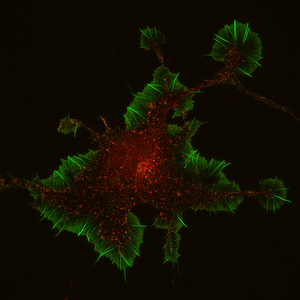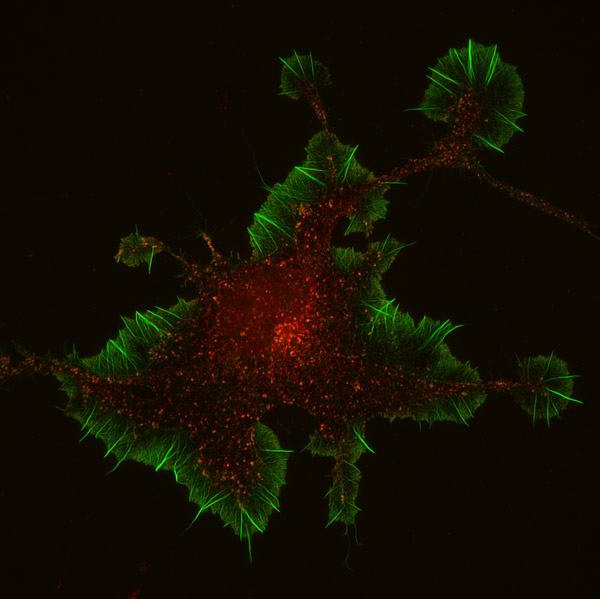Nobel Prize—Seeing Single Molecules
The 2014 Nobel Prize in Chemistry recognizes the work of Eric Bertzig, Stefan W. Hell, and William E. Moerner, who developed techniques in super-resolved fluorescence microscopy. One of the first breakthroughs in this field was the optical detection of a single molecule inside a solid crystal by Moerner in 1989. Previously, single molecules were thought to be optically undetectable.
When researchers study a particular molecule, they typically collect data from a large number of those molecules, but this collective approach hides individual variations that can exist between molecules. A protein, for example, is constantly changing shape, so a snapshot of many proteins will be an average over all those different forms. Environment can also affect the way molecules behave. If a certain molecule is dispersed sparsely throughout a solid matrix, the frequency of a single line in its spectrum will vary from one molecule to the next because each one is influenced by different local defects in its immediate environment. This spread in frequencies, which is called inhomogeneous broadening, has been a problem for precision measurements. “Moerner had the revolutionary idea to eliminate inhomogeneity effects completely by just addressing one single molecule,” says Lothar Kador, Moerner’s postdoctoral associate at the time, who is now at the University of Bayreuth in Germany.
The single molecule in Moerner’s 1989 paper was a hydrocarbon called pentacene. Moerner and Kador performed absorption spectroscopy on a low concentration of pentacene molecules incorporated in an organic crystal and chilled to near absolute zero. At these temperatures, the pentacene molecules should have a very narrow absorption line at 593 nanometers, but this line is broadened by 1000 times due to inhomogeneities in the crystal. Although such broadening is usually a nuisance, Moerner and Kador found a way to use the effect to detect a single molecule. They tuned a laser to a frequency in the tail at the edge of the spectral line, where the number of absorbing molecules was expected to drop to one or very close to one.
To identify the weak signal from a single pentacene molecule, the researchers used two types of “modulation” that reduce the noisy background: The first was frequency-modulation (FM) spectroscopy, in which the laser frequency oscillates over a small range. The second modulation was an oscillation in the position of the absorption peak, which the researchers induced by applying either a time-varying electric field or a time-varying stress from ultrasound waves. Under this double modulation, the spectral signature of a single pentacene molecule was a combination of peaks and dips in the shape of a W. The team detected several of these W-shaped features at different frequencies. To verify that the observed signature was due to a single molecule, Moerner and Kador increased or decreased the modulation frequency of their FM technique. In response, the W feature expanded or contracted—as expected for a single molecule—rather than changing in a random way, as would be expected if the feature came from several absorbing molecules with a range of central frequencies.
The physics community wasn’t entirely convinced at first, says Michel Orrit of Leiden University in the Netherlands. The data contained a lot of noise, and many people still had doubts that single molecule observation was even possible with light. Most skeptics were converted a year later, however, when Orrit and a collaborator redid the experiment, but instead of absorption they detected the fluorescent emission from a single pentacene molecule [1]. Fluorescence became the method of choice in single molecule detection, since it typically generates less background noise than absorption studies, Orrit says.
Years later, researchers discovered fluorescent proteins whose emission could be turned on and off. Methods soon developed in which a complex structure, like a cell membrane, is labeled (or “tagged”) with a large number of these beacon-like molecules. By turning on the proteins only a handful at a time, biologists precisely map out the location of each tag. They then combine these different maps into a super-resolution image of the full structure. “When we started our work, we did not plan to build a super-resolving microscope,” Kador says. “But in the course of time it turned out that single-molecule detection is able to achieve exactly this.”
This research is published in Physical Review Letters.
–Michael Schirber
Michael Schirber is a Corresponding Editor for Physics Magazine based in Lyon, France.
References
- M. Orrit and J. Bernard, “Single Pentacene Molecules Detected by Fluorescence Excitation in a p-terphenyl Crystal,” Phys. Rev. Lett. 65, 2716 (1990)





